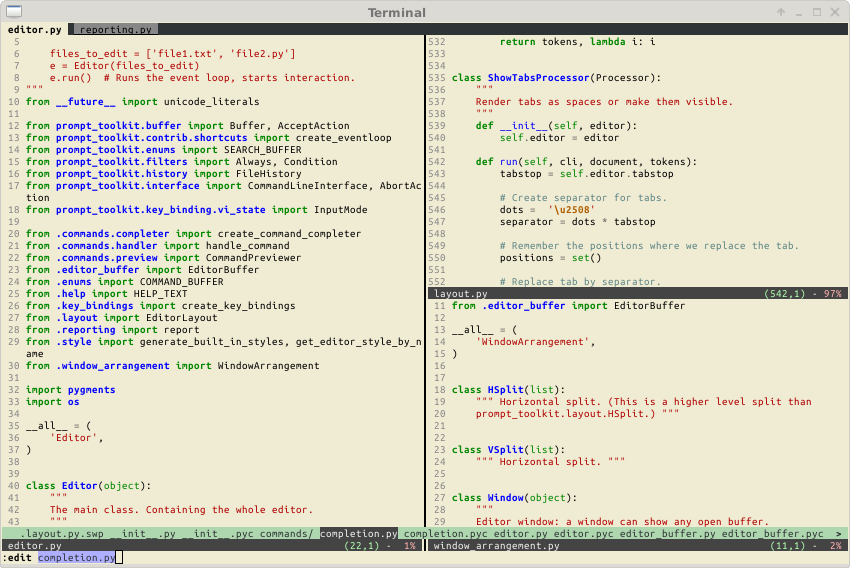Python Prompt Toolkit¶
prompt_toolkit is a library for building powerful interactive command lines and terminal applications in Python.
It can be a pure Python replacement for GNU readline, but it can be much more than that.
Some features:
- Syntax highlighting of the input while typing. (For instance, with a Pygments lexer.)
- Multi-line input editing.
- Advanced code completion.
- Selecting text for copy/paste. (Both Emacs and Vi style.)
- Mouse support for cursor positioning and scrolling.
- Auto suggestions. (Like fish shell.)
- No global state.
Like readline:
- Both Emacs and Vi key bindings.
- Reverse and forward incremental search.
- Works well with Unicode double width characters. (Chinese input.)
Works everywhere:
- Pure Python. Runs on all Python versions from 2.6 up to 3.4.
- Runs on Linux, OS X, OpenBSD and Windows systems.
- Lightweight, the only dependencies are Pygments, six and wcwidth.
- No assumptions about I/O are made. Every prompt_toolkit application should also run in a telnet/ssh server or an asyncio process.
Two use cases: prompts versus full screen terminal applications¶
prompt_toolkit was in the first place meant to be a replacement for
readline. However, when it became more mature, we realised that all the
components for full screen applications are there and prompt_toolkit is
very capable of handling many use cases. Pyvim and pymux are examples of full screen
applications.

Basically, at the core, prompt_toolkit has a layout engine, that supports
horizontal and vertical splits as well as floats, where each “window” can
display a user control. The API for user controls is simple yet powerful.
When prompt_toolkit is used to simply read some input from the user, it
uses a rather simple built-in layout. One that displays the default input
buffer and the prompt, a float for the autocompletions and a toolbar for input
validation which is hidden by default.
For full screen applications, usually we build the layout ourself, because it’s very custom.
Further, there is a very flexible key binding system that can be programmed for all the needs of full screen applications.
Installation¶
pip install prompt_toolkit
For Conda, do:
conda install -c https://conda.anaconda.org/conda-forge prompt_toolkit
Getting started¶
The following snippet is the most simple example, it uses the
prompt() function to asks the user for input
and returns the text. Just like (raw_)input.
from __future__ import unicode_literals
from prompt_toolkit import prompt
text = prompt('Give me some input: ')
print('You said: %s' % text)
For more information, start reading the building prompts section.
Thanks to:¶
Thanks to all the contributors for making prompt_toolkit possible.
Also, a special thanks to the Pygments and wcwidth libraries.
Table of contents¶
- Gallery
- Building prompts
- Building full screen applications
- Architecture
- Reference